University Personal Leadership Model: A Comprehensive Analysis
VerifiedAdded on 2020/01/16
|8
|1948
|208
Report
AI Summary
This report provides a comprehensive analysis of a personal leadership model, discussing various leadership theories, including situational, participative, expectancy, transactional, and transformational leadership. It emphasizes the importance of self-awareness, communication skills, and the ability to motivate teams. The report explores the strengths and weaknesses of different leadership styles, highlighting the need for leaders to adapt their approach based on the situation and the needs of their team members. It also proposes a personal leadership model that emphasizes building strong relationships, fostering open communication, and empowering team members to achieve high-level goals. The report concludes by underscoring the significance of leadership in organizational success and the qualities of an effective leader, such as motivation, patience, knowledge, and the ability to plan and adjust to different situations. This is a great resource for students to learn about leadership models.
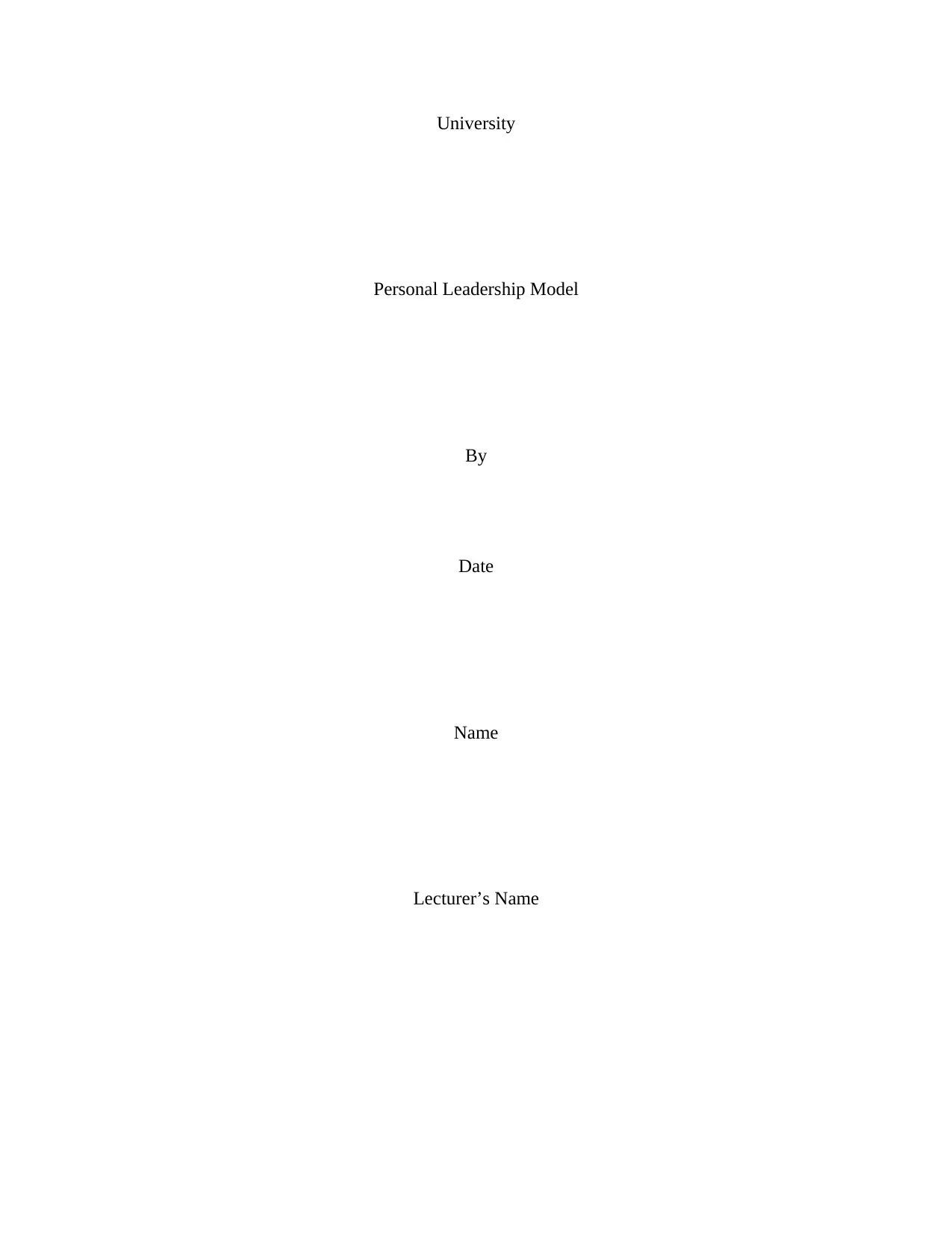
University
Personal Leadership Model
By
Date
Name
Lecturer’s Name
Personal Leadership Model
By
Date
Name
Lecturer’s Name
Paraphrase This Document
Need a fresh take? Get an instant paraphrase of this document with our AI Paraphraser

Personal Leadership Model
Table of Contents
Personal Leadership Model:........................................................................................................................3
References...................................................................................................................................................8
Page 2 of 8
Table of Contents
Personal Leadership Model:........................................................................................................................3
References...................................................................................................................................................8
Page 2 of 8
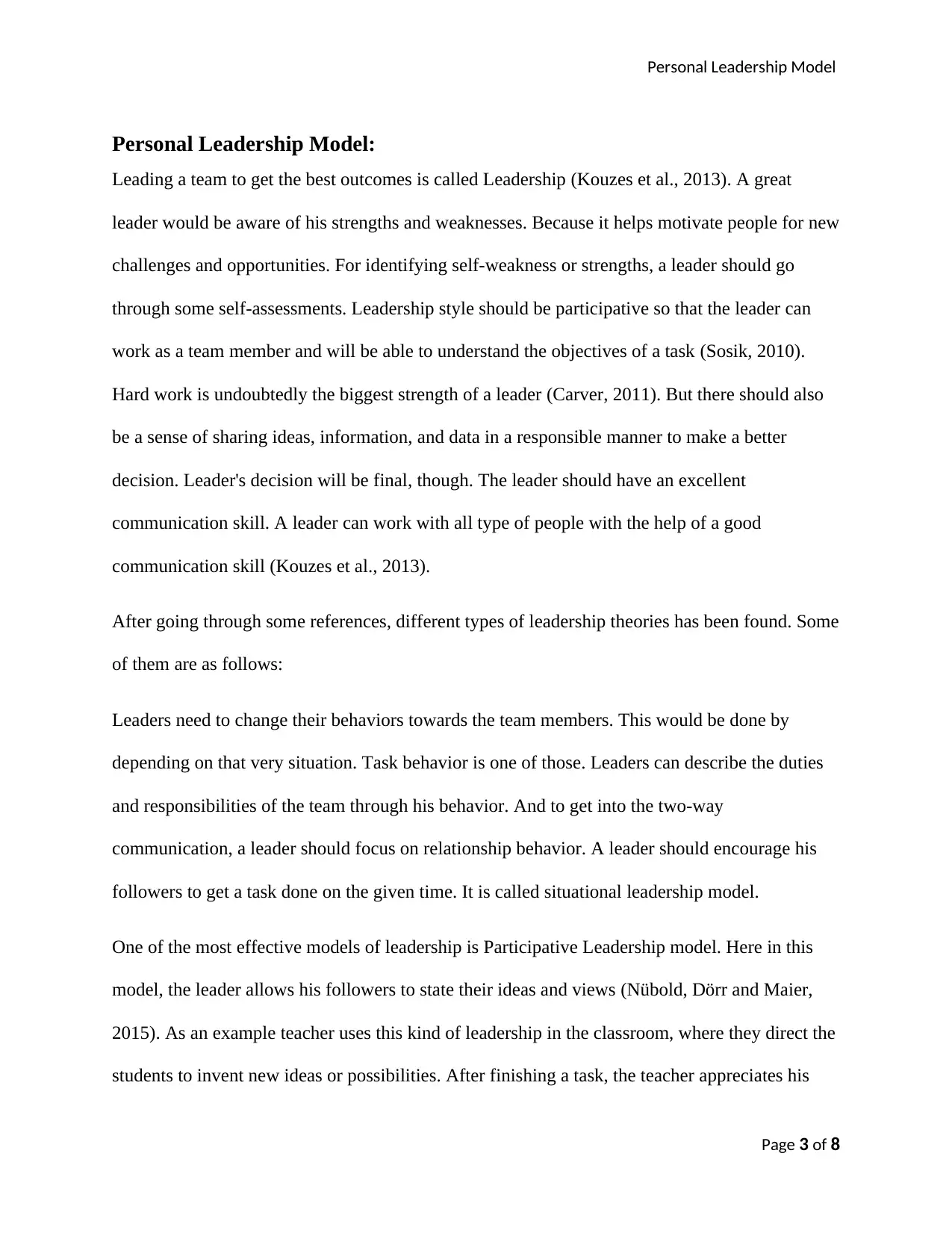
Personal Leadership Model
Personal Leadership Model:
Leading a team to get the best outcomes is called Leadership (Kouzes et al., 2013). A great
leader would be aware of his strengths and weaknesses. Because it helps motivate people for new
challenges and opportunities. For identifying self-weakness or strengths, a leader should go
through some self-assessments. Leadership style should be participative so that the leader can
work as a team member and will be able to understand the objectives of a task (Sosik, 2010).
Hard work is undoubtedly the biggest strength of a leader (Carver, 2011). But there should also
be a sense of sharing ideas, information, and data in a responsible manner to make a better
decision. Leader's decision will be final, though. The leader should have an excellent
communication skill. A leader can work with all type of people with the help of a good
communication skill (Kouzes et al., 2013).
After going through some references, different types of leadership theories has been found. Some
of them are as follows:
Leaders need to change their behaviors towards the team members. This would be done by
depending on that very situation. Task behavior is one of those. Leaders can describe the duties
and responsibilities of the team through his behavior. And to get into the two-way
communication, a leader should focus on relationship behavior. A leader should encourage his
followers to get a task done on the given time. It is called situational leadership model.
One of the most effective models of leadership is Participative Leadership model. Here in this
model, the leader allows his followers to state their ideas and views (Nübold, Dörr and Maier,
2015). As an example teacher uses this kind of leadership in the classroom, where they direct the
students to invent new ideas or possibilities. After finishing a task, the teacher appreciates his
Page 3 of 8
Personal Leadership Model:
Leading a team to get the best outcomes is called Leadership (Kouzes et al., 2013). A great
leader would be aware of his strengths and weaknesses. Because it helps motivate people for new
challenges and opportunities. For identifying self-weakness or strengths, a leader should go
through some self-assessments. Leadership style should be participative so that the leader can
work as a team member and will be able to understand the objectives of a task (Sosik, 2010).
Hard work is undoubtedly the biggest strength of a leader (Carver, 2011). But there should also
be a sense of sharing ideas, information, and data in a responsible manner to make a better
decision. Leader's decision will be final, though. The leader should have an excellent
communication skill. A leader can work with all type of people with the help of a good
communication skill (Kouzes et al., 2013).
After going through some references, different types of leadership theories has been found. Some
of them are as follows:
Leaders need to change their behaviors towards the team members. This would be done by
depending on that very situation. Task behavior is one of those. Leaders can describe the duties
and responsibilities of the team through his behavior. And to get into the two-way
communication, a leader should focus on relationship behavior. A leader should encourage his
followers to get a task done on the given time. It is called situational leadership model.
One of the most effective models of leadership is Participative Leadership model. Here in this
model, the leader allows his followers to state their ideas and views (Nübold, Dörr and Maier,
2015). As an example teacher uses this kind of leadership in the classroom, where they direct the
students to invent new ideas or possibilities. After finishing a task, the teacher appreciates his
Page 3 of 8
⊘ This is a preview!⊘
Do you want full access?
Subscribe today to unlock all pages.

Trusted by 1+ million students worldwide
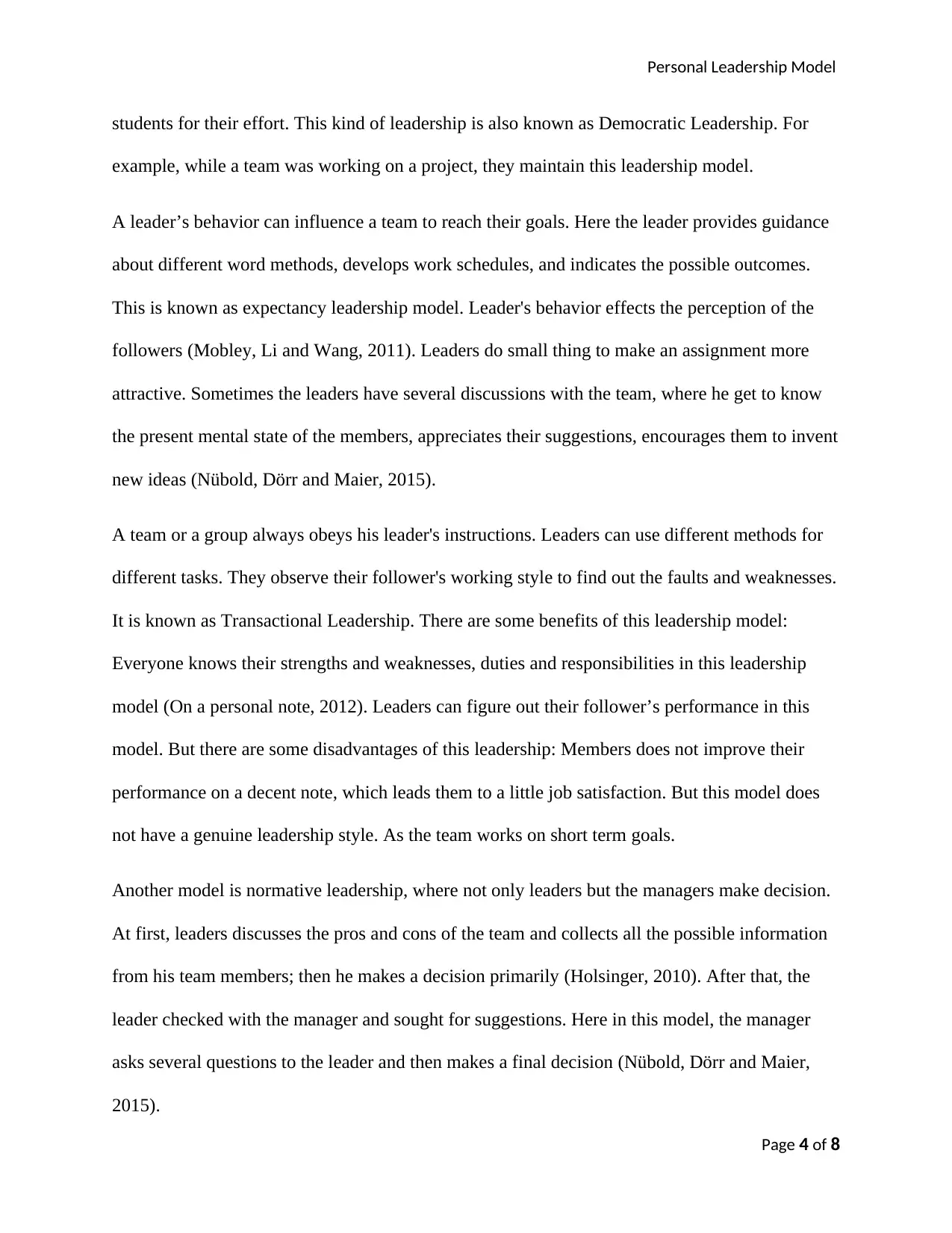
Personal Leadership Model
students for their effort. This kind of leadership is also known as Democratic Leadership. For
example, while a team was working on a project, they maintain this leadership model.
A leader’s behavior can influence a team to reach their goals. Here the leader provides guidance
about different word methods, develops work schedules, and indicates the possible outcomes.
This is known as expectancy leadership model. Leader's behavior effects the perception of the
followers (Mobley, Li and Wang, 2011). Leaders do small thing to make an assignment more
attractive. Sometimes the leaders have several discussions with the team, where he get to know
the present mental state of the members, appreciates their suggestions, encourages them to invent
new ideas (Nübold, Dörr and Maier, 2015).
A team or a group always obeys his leader's instructions. Leaders can use different methods for
different tasks. They observe their follower's working style to find out the faults and weaknesses.
It is known as Transactional Leadership. There are some benefits of this leadership model:
Everyone knows their strengths and weaknesses, duties and responsibilities in this leadership
model (On a personal note, 2012). Leaders can figure out their follower’s performance in this
model. But there are some disadvantages of this leadership: Members does not improve their
performance on a decent note, which leads them to a little job satisfaction. But this model does
not have a genuine leadership style. As the team works on short term goals.
Another model is normative leadership, where not only leaders but the managers make decision.
At first, leaders discusses the pros and cons of the team and collects all the possible information
from his team members; then he makes a decision primarily (Holsinger, 2010). After that, the
leader checked with the manager and sought for suggestions. Here in this model, the manager
asks several questions to the leader and then makes a final decision (Nübold, Dörr and Maier,
2015).
Page 4 of 8
students for their effort. This kind of leadership is also known as Democratic Leadership. For
example, while a team was working on a project, they maintain this leadership model.
A leader’s behavior can influence a team to reach their goals. Here the leader provides guidance
about different word methods, develops work schedules, and indicates the possible outcomes.
This is known as expectancy leadership model. Leader's behavior effects the perception of the
followers (Mobley, Li and Wang, 2011). Leaders do small thing to make an assignment more
attractive. Sometimes the leaders have several discussions with the team, where he get to know
the present mental state of the members, appreciates their suggestions, encourages them to invent
new ideas (Nübold, Dörr and Maier, 2015).
A team or a group always obeys his leader's instructions. Leaders can use different methods for
different tasks. They observe their follower's working style to find out the faults and weaknesses.
It is known as Transactional Leadership. There are some benefits of this leadership model:
Everyone knows their strengths and weaknesses, duties and responsibilities in this leadership
model (On a personal note, 2012). Leaders can figure out their follower’s performance in this
model. But there are some disadvantages of this leadership: Members does not improve their
performance on a decent note, which leads them to a little job satisfaction. But this model does
not have a genuine leadership style. As the team works on short term goals.
Another model is normative leadership, where not only leaders but the managers make decision.
At first, leaders discusses the pros and cons of the team and collects all the possible information
from his team members; then he makes a decision primarily (Holsinger, 2010). After that, the
leader checked with the manager and sought for suggestions. Here in this model, the manager
asks several questions to the leader and then makes a final decision (Nübold, Dörr and Maier,
2015).
Page 4 of 8
Paraphrase This Document
Need a fresh take? Get an instant paraphrase of this document with our AI Paraphraser

Personal Leadership Model
Sometimes leaders motivate his followers to go for a broader task by their own. As a result, team
members set higher-level goals, become more confidence, and achieve surprising consignment.
This kind of leadership is called Transformational Leadership. Some factors can effect this
leadership model:
Firstly, Leader should understand the priorities of the given tasks.
Secondly, as per this model leaders focuses on the members individually.
Last but not the least, intellectual thinking of a leader can affect his job. Leaders appreciate the
followers to resolve the issues from a logical point of view.
Leaders maintain a significant relation with his team members (Kelly, 2011). Everyone wants to
be a leader regarding job, family, sports team, or community, etc. But a true leader is who can
lead a team properly, meet all the deadlines, have good relation with his subordinate, can set
goals for the team, motivate the team for new challenges, and can build a good rapport amongst
the followers. A personal leadership model has been set to spell out the leadership in an
appropriate way. Here in this model followers will be able to share their problems along with the
ideas with the leader. They can set a high-level goal to achieve the broader task. In this model,
leaders will have all the possible information before resolving any particular issue. The leader
will be able enough to solve all the problems on his own. There will be no need to involve a
manager to make a suitable decision. Thus the model will differentiate itself from the existing
ones. This model will lead a team as well as an organization to make a successful implement of
new ideas, which will cause the organization to rebuild its greater image in the market.
As per this model, a leader will first build a good relation with his followers. He will have some
team hurdles frequently to know the team well. The leader in this model describe the tasks to the
Page 5 of 8
Sometimes leaders motivate his followers to go for a broader task by their own. As a result, team
members set higher-level goals, become more confidence, and achieve surprising consignment.
This kind of leadership is called Transformational Leadership. Some factors can effect this
leadership model:
Firstly, Leader should understand the priorities of the given tasks.
Secondly, as per this model leaders focuses on the members individually.
Last but not the least, intellectual thinking of a leader can affect his job. Leaders appreciate the
followers to resolve the issues from a logical point of view.
Leaders maintain a significant relation with his team members (Kelly, 2011). Everyone wants to
be a leader regarding job, family, sports team, or community, etc. But a true leader is who can
lead a team properly, meet all the deadlines, have good relation with his subordinate, can set
goals for the team, motivate the team for new challenges, and can build a good rapport amongst
the followers. A personal leadership model has been set to spell out the leadership in an
appropriate way. Here in this model followers will be able to share their problems along with the
ideas with the leader. They can set a high-level goal to achieve the broader task. In this model,
leaders will have all the possible information before resolving any particular issue. The leader
will be able enough to solve all the problems on his own. There will be no need to involve a
manager to make a suitable decision. Thus the model will differentiate itself from the existing
ones. This model will lead a team as well as an organization to make a successful implement of
new ideas, which will cause the organization to rebuild its greater image in the market.
As per this model, a leader will first build a good relation with his followers. He will have some
team hurdles frequently to know the team well. The leader in this model describe the tasks to the
Page 5 of 8
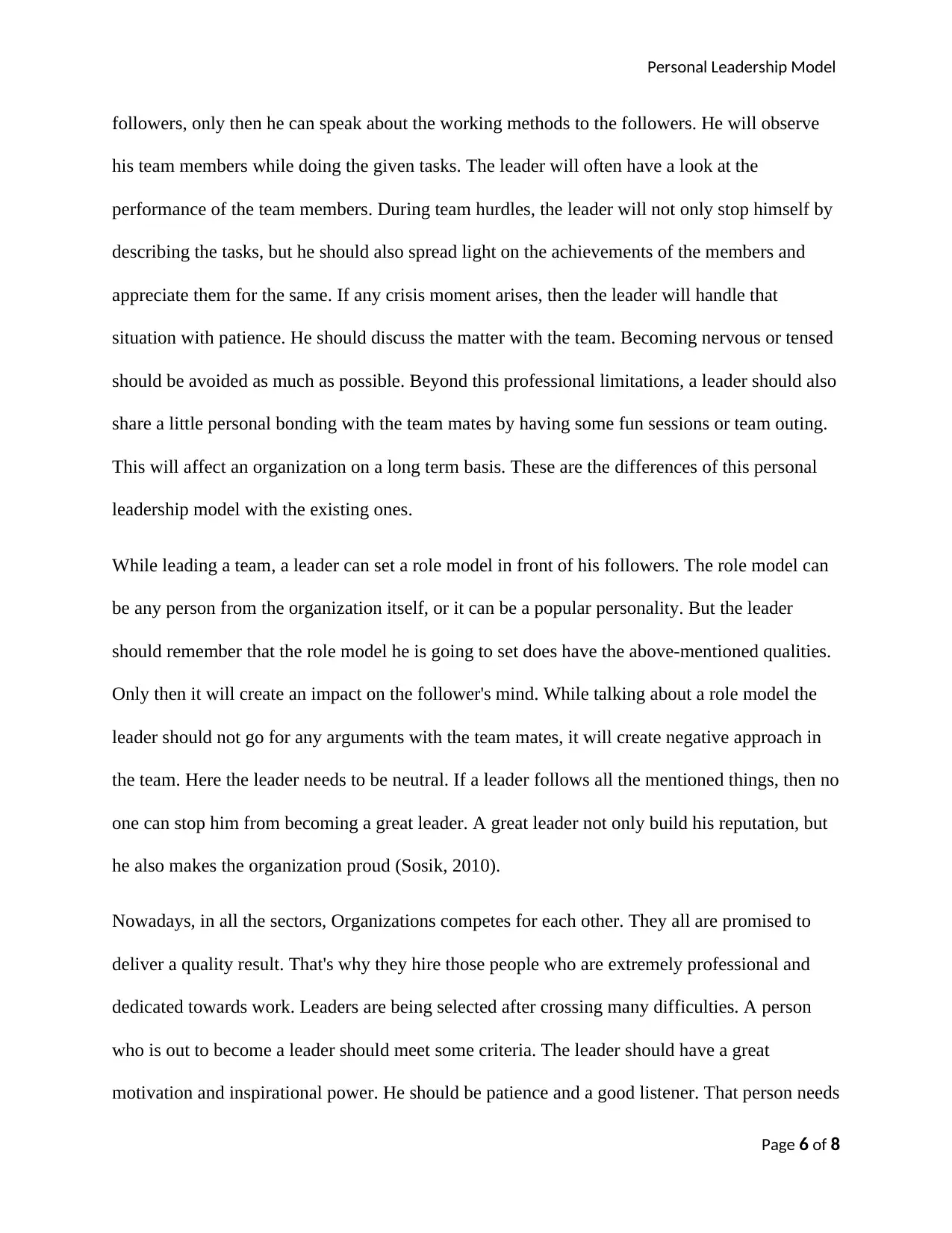
Personal Leadership Model
followers, only then he can speak about the working methods to the followers. He will observe
his team members while doing the given tasks. The leader will often have a look at the
performance of the team members. During team hurdles, the leader will not only stop himself by
describing the tasks, but he should also spread light on the achievements of the members and
appreciate them for the same. If any crisis moment arises, then the leader will handle that
situation with patience. He should discuss the matter with the team. Becoming nervous or tensed
should be avoided as much as possible. Beyond this professional limitations, a leader should also
share a little personal bonding with the team mates by having some fun sessions or team outing.
This will affect an organization on a long term basis. These are the differences of this personal
leadership model with the existing ones.
While leading a team, a leader can set a role model in front of his followers. The role model can
be any person from the organization itself, or it can be a popular personality. But the leader
should remember that the role model he is going to set does have the above-mentioned qualities.
Only then it will create an impact on the follower's mind. While talking about a role model the
leader should not go for any arguments with the team mates, it will create negative approach in
the team. Here the leader needs to be neutral. If a leader follows all the mentioned things, then no
one can stop him from becoming a great leader. A great leader not only build his reputation, but
he also makes the organization proud (Sosik, 2010).
Nowadays, in all the sectors, Organizations competes for each other. They all are promised to
deliver a quality result. That's why they hire those people who are extremely professional and
dedicated towards work. Leaders are being selected after crossing many difficulties. A person
who is out to become a leader should meet some criteria. The leader should have a great
motivation and inspirational power. He should be patience and a good listener. That person needs
Page 6 of 8
followers, only then he can speak about the working methods to the followers. He will observe
his team members while doing the given tasks. The leader will often have a look at the
performance of the team members. During team hurdles, the leader will not only stop himself by
describing the tasks, but he should also spread light on the achievements of the members and
appreciate them for the same. If any crisis moment arises, then the leader will handle that
situation with patience. He should discuss the matter with the team. Becoming nervous or tensed
should be avoided as much as possible. Beyond this professional limitations, a leader should also
share a little personal bonding with the team mates by having some fun sessions or team outing.
This will affect an organization on a long term basis. These are the differences of this personal
leadership model with the existing ones.
While leading a team, a leader can set a role model in front of his followers. The role model can
be any person from the organization itself, or it can be a popular personality. But the leader
should remember that the role model he is going to set does have the above-mentioned qualities.
Only then it will create an impact on the follower's mind. While talking about a role model the
leader should not go for any arguments with the team mates, it will create negative approach in
the team. Here the leader needs to be neutral. If a leader follows all the mentioned things, then no
one can stop him from becoming a great leader. A great leader not only build his reputation, but
he also makes the organization proud (Sosik, 2010).
Nowadays, in all the sectors, Organizations competes for each other. They all are promised to
deliver a quality result. That's why they hire those people who are extremely professional and
dedicated towards work. Leaders are being selected after crossing many difficulties. A person
who is out to become a leader should meet some criteria. The leader should have a great
motivation and inspirational power. He should be patience and a good listener. That person needs
Page 6 of 8
⊘ This is a preview!⊘
Do you want full access?
Subscribe today to unlock all pages.

Trusted by 1+ million students worldwide

Personal Leadership Model
to have the greater knowledge of the task. He should be a good planner (Kelly, 2011). The leader
should be straight-forward but polite to each and every followers. A good team leader should
adjust in all kind of situation. He should be ready for any changes.
Leadership becomes a very important part of every organization. Because sometimes an
organization's growth depends on its leadership qualities. If an organization has creative leaders,
then they prove themselves more than any other organization. Organizations should give enough
space to the leaders so that the leaders can work freely. It's an organization's responsibility to
make the leader confident about his work. Leaders need, to be honest, and collaborative at their
workplace. If an organization selects a perfect leader, then it helps them to set a new milestone
(Kelly, 2011). To know the leadership quality of own self then organizations can go for some
surveys or assessments, which will let them know about the performance and the popularity of
the leaders. Thus the organization can set new goals for leadership and make any changes in their
selection process if needed.
Page 7 of 8
to have the greater knowledge of the task. He should be a good planner (Kelly, 2011). The leader
should be straight-forward but polite to each and every followers. A good team leader should
adjust in all kind of situation. He should be ready for any changes.
Leadership becomes a very important part of every organization. Because sometimes an
organization's growth depends on its leadership qualities. If an organization has creative leaders,
then they prove themselves more than any other organization. Organizations should give enough
space to the leaders so that the leaders can work freely. It's an organization's responsibility to
make the leader confident about his work. Leaders need, to be honest, and collaborative at their
workplace. If an organization selects a perfect leader, then it helps them to set a new milestone
(Kelly, 2011). To know the leadership quality of own self then organizations can go for some
surveys or assessments, which will let them know about the performance and the popularity of
the leaders. Thus the organization can set new goals for leadership and make any changes in their
selection process if needed.
Page 7 of 8
Paraphrase This Document
Need a fresh take? Get an instant paraphrase of this document with our AI Paraphraser
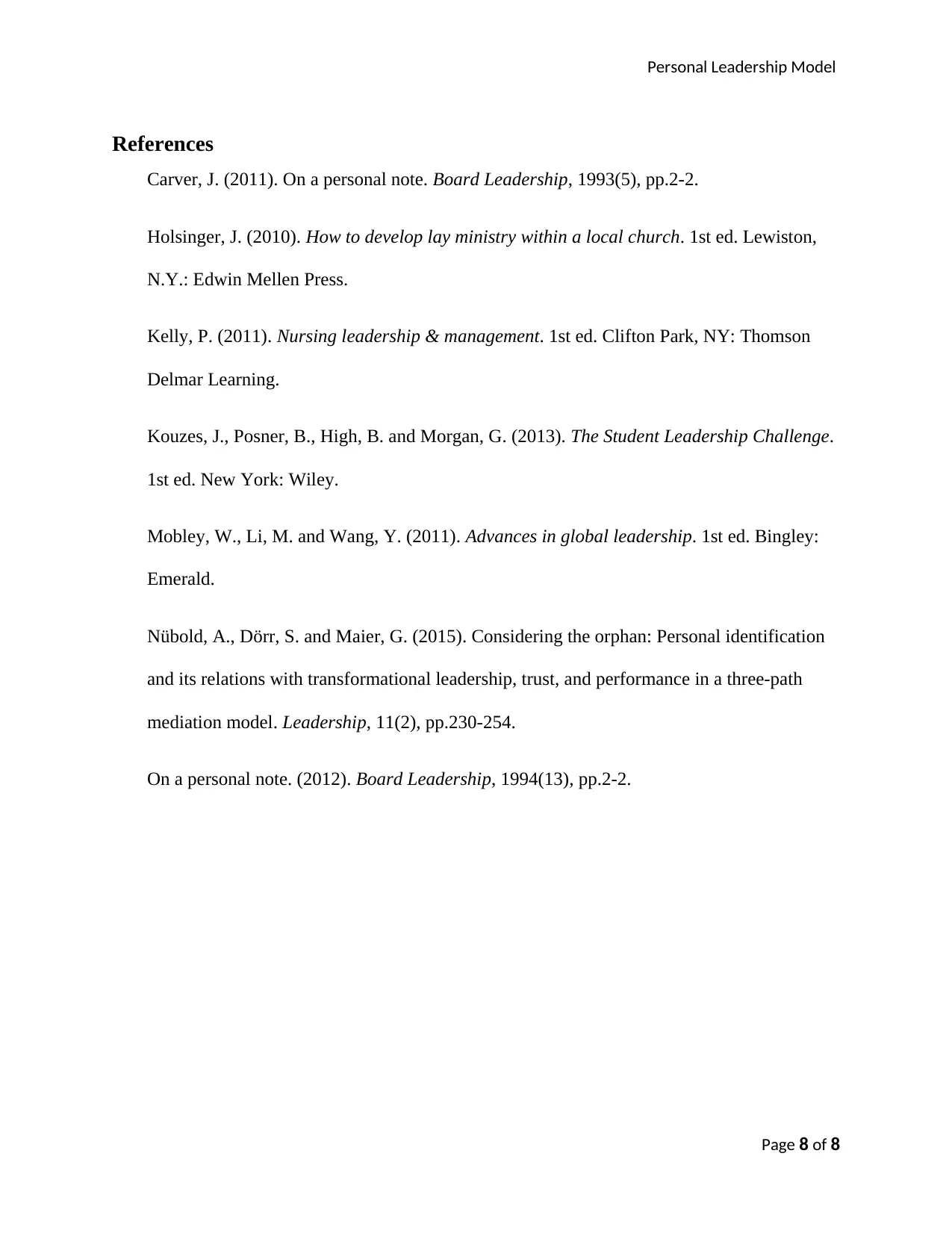
Personal Leadership Model
References
Carver, J. (2011). On a personal note. Board Leadership, 1993(5), pp.2-2.
Holsinger, J. (2010). How to develop lay ministry within a local church. 1st ed. Lewiston,
N.Y.: Edwin Mellen Press.
Kelly, P. (2011). Nursing leadership & management. 1st ed. Clifton Park, NY: Thomson
Delmar Learning.
Kouzes, J., Posner, B., High, B. and Morgan, G. (2013). The Student Leadership Challenge.
1st ed. New York: Wiley.
Mobley, W., Li, M. and Wang, Y. (2011). Advances in global leadership. 1st ed. Bingley:
Emerald.
Nübold, A., Dörr, S. and Maier, G. (2015). Considering the orphan: Personal identification
and its relations with transformational leadership, trust, and performance in a three-path
mediation model. Leadership, 11(2), pp.230-254.
On a personal note. (2012). Board Leadership, 1994(13), pp.2-2.
Page 8 of 8
References
Carver, J. (2011). On a personal note. Board Leadership, 1993(5), pp.2-2.
Holsinger, J. (2010). How to develop lay ministry within a local church. 1st ed. Lewiston,
N.Y.: Edwin Mellen Press.
Kelly, P. (2011). Nursing leadership & management. 1st ed. Clifton Park, NY: Thomson
Delmar Learning.
Kouzes, J., Posner, B., High, B. and Morgan, G. (2013). The Student Leadership Challenge.
1st ed. New York: Wiley.
Mobley, W., Li, M. and Wang, Y. (2011). Advances in global leadership. 1st ed. Bingley:
Emerald.
Nübold, A., Dörr, S. and Maier, G. (2015). Considering the orphan: Personal identification
and its relations with transformational leadership, trust, and performance in a three-path
mediation model. Leadership, 11(2), pp.230-254.
On a personal note. (2012). Board Leadership, 1994(13), pp.2-2.
Page 8 of 8
1 out of 8
Related Documents
Your All-in-One AI-Powered Toolkit for Academic Success.
+13062052269
info@desklib.com
Available 24*7 on WhatsApp / Email
![[object Object]](/_next/static/media/star-bottom.7253800d.svg)
Unlock your academic potential
Copyright © 2020–2025 A2Z Services. All Rights Reserved. Developed and managed by ZUCOL.



